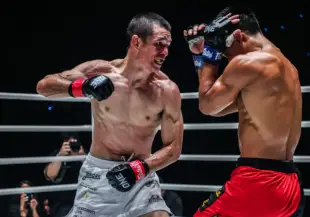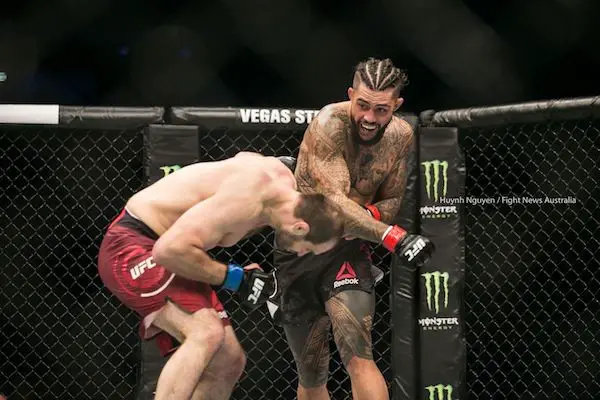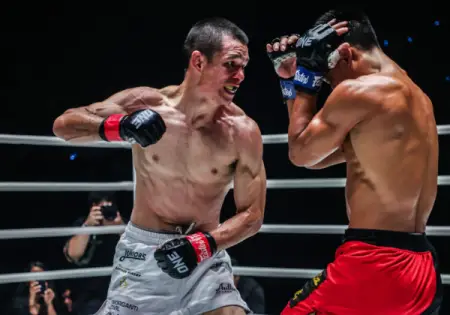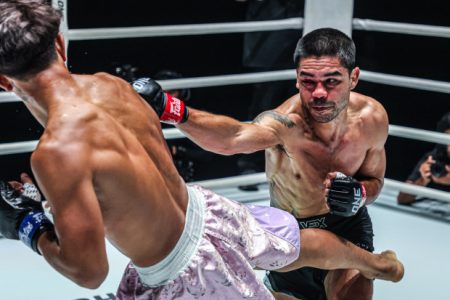Aussie sensation Tyson Pedro will compete in a pivotal matchup against Ovince Saint Preux on June 23rd in Singapore. Let’s take a closer look at some of the techniques that Pedro has used to achieve success inside the octagon.
The last time Tyson Pedro fought was at UFC 221, where he took on Saparbek Safarov. Early on in the first round, Safarov made his intentions clear when he caught Pedro’s kick and immediately scored with a takedown. Pedro then shuffled back toward the cage. Let’s take a closer look at what happened next.
Pedro secures an over-hook with his left arm and uses the cage to help him stand:

Using his left over-hook, Pedro leans his weight down and gains control of Safarov’s left wrist with his right hand.

This technique hinders Safarov’s offense in a few ways; it stops his ability to grab Pedro’s leg with his left hand, or use his right under-hook effectively, while also preventing Safarov from clasping his hands behind Pedro’s back. Pedro’s over-hook and wrist control allow him to create some distance between himself and Safarov.
Pedro then uses that small amount of space -created by the previous sequence- to frame on the left side of Safarov’s neck with his right arm, and circles away to create a full separation:

Around a minute later, Safarov attempts another takedown in the centre of the octagon:

Pedro uses the left over-hook (whizzer) again, and sprawls his hips back while circling to his left, he then controls Safarov’s posture on the way up to land a knee on the exit:

So far, we’ve seen Pedro’s ability to use the fence to help him stand, and his ability to defend takedowns both against the cage and in open space.
When a fighter is confronted with the threat of a takedown, he/she can sometimes be tempted to attack with a submission, rather than committing their energy to defending the takedown itself.
This tactic is common and has long been understood as high risk/high reward. Any attempt on a submission carries the bi-product of the fighter being preoccupied with it, and therefore leaving the fighter unable to commit one hundred percent of their energy (or limbs) to defending against the actual threat of being tossed to the ground. However, if successful, the submission could end the fight, and achieving instant victory is always tempting.
Toward the end of the first round, Safarov once again threatened with a takedown against the cage. Pedro’s feet were close together (more on that to follow) and he was faced with a choice of how to utilize his upper body.
- Defending the takedown, by either;digging for under-hooks, (or as seen above) using a whizzer and/or fighting the wrists of Safarov.
- By attackingSafarov with a submission.
Here, Safarov’s neck position appears to offer Pedro a tempting, and seemingly easy target.
Pedro elects to threaten with a submission on Safarov’s neck, but without an over-hook/under-hook, or wrist control, Safarov easily lifts Pedro:

And slams him to the canvas:

Directly after the failed guillotine attempt, Pedro was able to stand up without too much difficulty. Safarov then followed him to the cage, where the two fighters ended up in a very similar position to the one they were in moments earlier. However, this time Pedro made some critical adjustments and was rewarded with a vastly different result.
As previously explained, if a fighter chooses to attack with a submission in sequences such as these, it often comes at a cost of relinquishing their ability to defend the actual takedown. This time, Tyson Pedro finds a way to do both; he defends the takedown with his lower body, while simultaneously using his upper body to attack with a submission. As shown above, during the first sequence, Pedro’s feet were together, this makes it substantially more difficult for him to stop the takedown. A commonly used takedown defence technique when a fighter’s back is pinned to the cage –and unable to sprawl their hips backward- is to utilize a wider base with their legs spread, thus expanding the gap between their opponent’s arms.
Here we see Pedro defend the takedown with his lower body by widening his stance, while simultaneously using his upper body to attack with a Kimura:

Safarov understands that Pedro is threatening his left arm and keeps it tight against Pedro’s leg, preventing Pedro from locking up his hands for the necessary grip:

Up until this point, the tactics that we have examined from Tyson Pedro are -while highly skilful- quite common. However In the closing sequence of the bout, Pedro shows a uniquely dangerous ability to adapt to his opponents’ defensive tactic, while setting a beautiful trap, and defending the takedown threat, all at once.
Pedro immediately realizes that he doesn’t have space to lock the Kimura grip, he then adjusts to a “switch” (placing his left arm inside Safarov’s left leg):

At this moment Safarov takes the bait and makes a critical error by moving his head to the other side of Pedro’s body, in an attempt to free his own leg and get behind Pedro:

The adjustment from Safarov immediately grants Pedro enough space to lock the Kimura grip, the very thing Pedro wanted all along:

Once Pedro has the grip, he uses it to wrench Safarov’s shoulder, forcing Safarov to roll in order to relieve the pressure:

Pedro ends up on top with the Kimura locked, then steps over Safarov’s head to finish the submission:

Tyson Pedro is young in MMA years, however sequences like these show just how crafty he is. He has spent almost his entire lifetime training and competing in various combative disciplines; this beautifully executed Kimura trap is a prime example of the culmination of that training.
The upcoming match up against former UFC Title challenger, Ovince Saint Preux at UFC Singapore on June 24th is pivotal for Pedro. He will surely need to bring all of his skills, tricks and traps, if he is to achieve victory over the most dangerous challenge that he has faced thus far.
Dana White confirms the UFC will return to Australia this year







